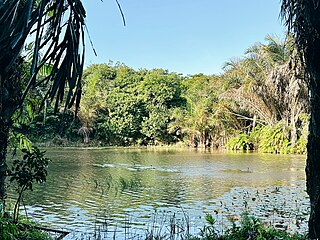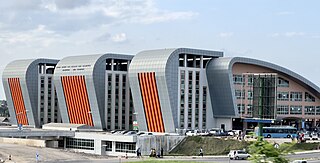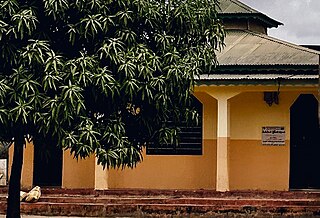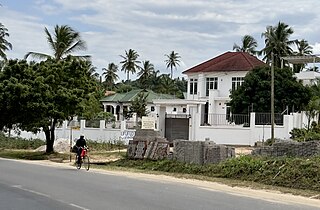
Dar es Salaam is the largest city and financial hub of Tanzania. It is also the capital of the Dar es Salaam Region. With a population of over five million people, Dar es Salaam is the largest city in East Africa and the sixth-largest in Africa. Located on the Swahili coast, Dar es Salaam is an important economic center and one of the fastest-growing cities in the world.

Kariakoo is an administrative ward of the Ilala Municipical Council of the Dar es Salaam Region in Tanzania. Jangwani ward and Mchafukoge ward form the ward's northern and eastern boundaries. The Gerezani and Mchikichini wards border the ward to the south and west respectively. The ward is the home of Simba Sports Club. The name is derived from the swahilization of the British colonial occupation's "Carrier Corps", that used to be based in the area. Today, Kariakoo is mainly known for its large market that spans several city blocks. According to the 2012 census, the ward has a population of 13,780.

Dar es Salaam Region is one of Tanzania's 31 administrative regions and is located in the east coast of the country. The region covers an area of 1,393 km2 (538 sq mi). The region is comparable in size to the combined land and water areas of the nation state of Mauritius Dar es Salaam Region is bordered to the east by Indian Ocean and it is entirely surrounded by Pwani Region. The Pwani districts that border Dar es Salaam region are Bagamoyo District to the north, Kibaha Urban District to the west, Kisarawe District to the south west and Mkuranga District to the south of the region. The region's seat (capital) is located inside the ward of Ilala. The region is named after the city of Dar es Salaam itself. The region is home to Tanzania's major finance, administration and industries, thus the making it the country's richest region. The region also has the second highest Human Development Index in the country after Mjini Magharibi. According to the 2022 census, the region has a total population of 5,383,728 and national census of 2012 had 4,364,541. The region has the highest population in Tanzania followed by Mwanza Region.

Kinondoni District, officially the Kinondoni Municipal Council is one of five districts of the Dar es Salaam Region of Tanzania. The district is bordered to the north by Bagamoyo District and Kibaha of Pwani Region, to the east by the Indian Ocean, the west by Ubungo District, and to the south by the Ilala District. The district covers an area of 269.5 km2 (104.1 sq mi). The district is comparable in size to the land area of Malta. The administrative seat is Ndugumbi. The district is home to one of the best preserved Medieval Swahili settlements, Kunduchi Ruins, headquarters for the National Muslim Council of Tanzania (BAKWATA) and Makumbusho Village Museum. Considered the cultural center of Dar es Salaam, Kinondoni District is also regarded the birthplace of the musical genre of Singeli. In addition the district is one of two districts in Dar es Salaam that has a National Historic Site, namely the Kunduchi Ruins.The 2012 National Tanzania Census states the population for Kinondoni as 1,775,049.

Ilala District, officially the Ilala Municipal Council is one of five districts of the Dar es Salaam Region of Tanzania. The district is bordered to the north and northeast by Kinondoni District and Ubungo District, to the east by the Zanzibar Channel, the west by Pwani Region, and to the south by the Temeke District. It covers an area of 364.9 km2 (140.9 sq mi). The district is comparable in size to the land area of U.S Virgin Islands. The administrative seat is Mchafukoge. The 2012 National Tanzania Census states the population for Ilala as 1,220,611.

Ubungo District, officially the, Ubungo Municipal Council is one of five districts of the Dar es Salaam Region of Tanzania. The Kinondoni District and Kibaha of the Pwani Region border the district to the north; the Kisarawe District of Pwani Region borders it to the west; and the Ilala District borders the it to the south and east. The district covers an area of 269.4 km2 (104.0 sq mi). The district is comparable in size to the land area of St. Kitts and Nevis. The administrative seat is Kwembe. The district is home to the University of Dar es Salaam, The Magufuli Bus Terminal, the largest in the country, and Pande Game Reserve the largest protected land area in Dar es Salaam Region. In addition, the district is home to the largest natural gas powered power station, the Ubungo Thermal Power Station and the headquarters of the Tanzania Electric Supply Company Limited (TANESCO). The 2012 National Tanzania Census states the population of the district as 845,368.

Kisarawe District Council is one of eight administrative districts of Pwani Region in Tanzania. The District covers an area of 5,031 km2 (1,942 sq mi). It is bordered to the east by Dar es Salaam Region's Ilala and Ubungo Municipal Councils. The Kibaha District and Kibaha Town Council border the district to the north, and the Mkuranga District and Kibiti District border it to the south-east. By the Rufiji District to the south, and the Morogoro District of the Morogoro Region to the west. The district is comparable in size to the land area of Trinidad and Tobago. The town of Kisarawe serves as its administrative capital. According to the 2022 Tanzania National Census, the population of the District was 159,226.

Mkuranga District Council is one of eight administrative districts of Pwani Region in Tanzania. The District covers an area of 2,827 km2 (1,092 sq mi). It is bordered to the north by Dar es Salaam's Kigamboni, Temeke and Ilala Districts. To the east by the Mafia Channel, to the south by Kibiti District, and to the west by Kisarawe District. The district is comparable in size to the land area of Samoa. The town of Mkuranga serves as its administrative capital. The district is home to the Vikindu Forest Reserve, one of last remaining East African coastal forests. In 2016 the Tanzania National Bureau of Statistics report the population of Mkuranga District were 243,062 people in the district, from 222,921 in 2012.

Mbezi is an administrative ward in Ubungo District of the Dar es Salaam Region in Tanzania. Mabwepande and Wazo of Kinondoni MC border the ward to the north. The ward is bordered to the east by the wards of Saranga and Goba. South of here is Msigani. The westernmost wards are Kwembe, Kibamba, Maili Moja, and Pangani, the latter two of Kibaha. The ward is home to the majority of Pande Game Reserve's area. The ward is named after the Mbezi River, which passes through it. According to the 2012 census, the ward has a total population of 73,414.

Kigamboni District, officially known as The Kigamboni Municipal Council is one of five districts of the Dar es Salaam Region of Tanzania. The district is bordered to the north by Ilala District, to the east by the Indian Ocean, the west by Temeke District, and to the south by the Mkuranga District of Pwani Region. It covers an area of 578.3 km2 (223.3 sq mi), making it the largest district the region by area. The district is comparable in size to the land area of Micronesia. The administrative seat is Somangila. The district is home to the headquarters of the Tanzanian Navy, The Kigamboni Naval Base. Also the district is home to the prestigious Mwalimu Nyerere Memorial Academy. In addition the district is one of two districts in Dar es Salaam that has a National Historic Site, with Kigamboni hosting the most, namely the Kimbiji Ruins, Mbutu Bandarini and Mbuamaji historic sites. The 2012 National Tanzania Census states the population for Kigamboni as 162,932.

Kisarawe II or unofficially East Kisarawe is an administrative ward in the Kigamboni district of the Dar es Salaam Region of Tanzania. The Kibada and Mjimwema form the ward's northern border. East is Somangila. Pembamnazi borders it to the south. Toangoma in the Temeke District, as well as Vianzi and Vikindu in the Pwani Region's Mkuranga District, border the west. Since Kisarawe II is the district's top agricultural producer, it is known as Kigamboni's "ricebowl" and "food basket". In 2016 the Tanzania National Bureau of Statistics report there were 10,401 people in the ward, from 8,306 in 2012.
The Kazimzumbwi Forest Reserve, officially listed as Pugu/Kazimzumbwi Nature Forest Reserve is a protected area located in Kisarawe ward of Kisarawe District in Pwani Region, Tanzania. It is located next to the Pugu ward of Ilala MC to the east, about 20 km (12 mi) south-west of Dar es Salaam. It covers an area of 4,887 hectares, at an altitude between 120 and 180 m. The reserve was established in 1936, but both agriculture and logging were tolerated for several years. Logging, in particular, went on until the 1970s.

The Pugu Hills Forest Reserve, officially listed as Pugu/Kazimzumbwi Nature Forest Reserve is a protected area located in Kisarawe ward of Kisarawe District in Pwani Region, Tanzania. The forest borders in the Pugu ward, of Ilala MC in Dar es Salaam to the east, adjacent to the Kazimzumbwi Forest Reserve. Together with Kazimzumbwi, the Pugu Forest is part of what is considered to be one of the oldest forests in the world. The area is characterized by a large variety of endemic species of animals and plants.

Pugu is an administrative ward of the Ilala Municipical Council of the Dar es Salaam Region in Tanzania. Kinyerezi and Kwembe ward of Kinondoni MC form the ward's northern boundary. The ward is bordered by Majohe to the south and Gongolamboto to the east. In the west the ward is bordered by Kisarawe ward of Kisarawe District in the Pwani Region. The ward is named after the Pugu Hills, which form its western border and are home to the Pugu Hills Forest Reserve and the Kazimzumbwi Forest Reserve, two of some of the world's oldest forests. According to the 2012 census, the ward has a total population of 49,422.
Julius Nyerere Hydropower Station is a hydroelectric dam under construction across the Rufiji River in eastern Tanzania. Although controversial, the government approved the plans in 2018. The power station is expected to have an installed capacity of 2,115 megawatts (2,836,000 hp) and to produce 5,920GWh of power annually. The project, power station and dam are owned by and will be managed by the government owned Tanzania Electric Supply Company (TANESCO). Construction began in 2019 and is expected to be completed in 2024.

Majohe is an administrative ward of the Ilala Municipical Council of the Dar es Salaam Region in Tanzania. The communities of Ukonga, Gongolamboto, and Pugu border the ward on the north. By Kisarawe Ward in Kisarawe District in Pwani Region, to the west. Chanika and Msongola form the southern boundary of the ward. Kivule borders the ward on its eastern side. According to the 2012 census, the ward has a total population of 81,646.
The Pande Game Reserve is a protected area located in Mabwepande ward of Kinondoni District and Mbezi ward of Ubungo District in Dar es Salaam Region of Tanzania that covers an area of 15.39 km2 (5.94 sq mi). It was established as a Forest Reserve in 1952 under the British colonial occupation.
Mpiji River is located in the north east of Pwani Region and western Dar es Salaam Region of Tanzania. It begins in Masaki ward in Kisarawe District and eventually drains into Zanzibar Channel at the border of Mbweni ward of Kinondoni MC of Dar es Salaam and Kerege ward of Bagamoyo District of Pwani Region.
Mbezi River is located in Dar es Salaam Region of Tanzania. It begins in Kwembe ward in Ubungo MC and eventually drains into Zanzibar Channel at Kawe ward of Kinondoni MC. With several neighborhoods and two wards bearing its name, the river has a long history in Dar es Salaam.
Kwale Island is a protected, seasonally inhabited island in the Pemba Channel under the Tanga Marine Reserves (TMRS) with the IUCN category II located inside Kwale ward in Mkinga District of Tanga Region in Tanzania. The coral island, located approximately a kilometer offshore in Manza Bay, and the modern hamlet on the shoreline are both referred to as Kwale. 86.2% of Kwale Island, or 528.1 Ha, is covered with mangroves. Kwale Island and Ulenge Island are the only seasonally inhabited by islands in the marine reserve, thus the two have the most human impact. The Island has an average elevation of 7 m (23 ft).















